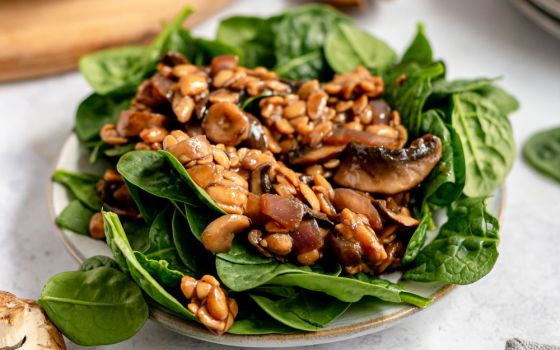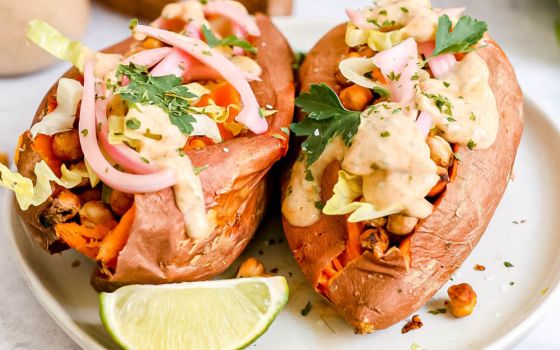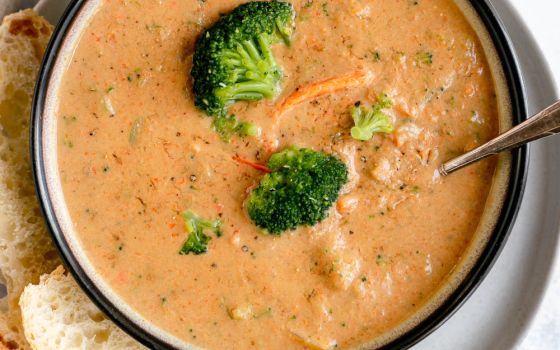
This dairy-free and cashew-free broccoli cheddar soup is still creamy and delicious. (At Elizabeth's Table/Elizabeth Varga)
Editor's Note: In this series, Elizabeth Varga will explore how fasting from meat impacts our relationships with self, others, the rest of creation and God. Her reflections and recipes will be posted on the Wednesdays and Fridays of Lent 2022. To receive this series via email, sign up for EarthBeat Reflections.
Many of us know the common Catholic grace before meals. We may pray it often without much thought: Bless us, O Lord, and these, thy gifts, which we are about to receive from thy bounty, through Christ, our Lord. Amen.
But why do we pray before meals? Why is it important?
Mealtime is a daily occurrence that gives us the opportunity to stop and thank God for life's blessings, especially for the food on our tables to which many others do not have access.
Our food came from somewhere. It was grown and harvested. It was transported. Mealtime is a great opportunity to ponder and reflect on the cycle of our food.
We often gather with family and friends for meals. Mealtime prayer can express gratitude for the community and fellowship with each other.
A pause before meals is an opportunity to be mindful of the food we eat. It can help us enjoy and savor the food instead of mindlessly consuming.
If you’re not sure how to pray before meals, start with something simple and quick, like the traditional Catholic grace before meals shared above.
Advertisement
If you want to be more specific about for what you are giving thanks, consider the reasons above for why it is important to pray before meals.
Thank God for the bounty that you have. Remember the cycle of your food and thank God for the farmers who grew it, the people who harvested it, the grocer who sold it and the hands that prepared it. Observe who you are eating with and praise God for those people. And finally, take a breath and prepare to mindfully eat — ask God to help you enjoy the food and honor God with your body as you eat.
You can come up with a different prayer each time you eat or you can pray the same one every time. Either way, try to be intentional as you pray. Mean the words as you say them.
Recipe: Vegan broccoli cheddar soup
You won’t miss the dairy in this plant-based broccoli cheddar soup — it's still creamy and delicious. Plus, it's made with whole food ingredients and ready in 30 minutes.

This dairy-free and cashew-free broccoli cheddar soup is still creamy and delicious. (At Elizabeth's Table/Elizabeth Varga)
Ingredients
- 3 cups frozen broccoli
- 1/2 yellow onion, chopped
- 3 tablespoons oat flour
- 1 tablespoon nutritional yeast
- 2 teaspoons garlic powder
- 2 cups nondairy milk
- 2 cups vegetable broth
- 1 cup shredded carrots
- 1 whole carrot
- 1/4 cup nut butter
- 1/2 cup nondairy yogurt or cream cheese
- 1 tablespoon lemon juice
- salt and pepper
Instructions
- Microwave the frozen broccoli according to the package instructions. When cool enough to handle, finely chop the broccoli.
- Sauté the onion in a large pot until soft, 3–5 minutes. Use a splash of the vegetable broth to prevent sticking.
- Add the flour, nutritional yeast and garlic powder. Stir to coat.
- Add the nondairy milk, vegetable broth, shredded carrots, whole carrot and nut butter. Bring to a simmer and let the carrots cook for 5 minutes until soft.
- Remove half the mixture, making sure to remove the whole carrot, and transfer to a food processor or blender. Blend until smooth. Then transfer the mixture back to the pot.
- Add the broccoli. Cook 3–5 minutes, until the entire soup is warm.
- Remove from the heat and stir in the yogurt and lemon juice. Taste and season with salt and pepper as desired. Enjoy!
Find recipe notes, substitutions and other nutritional information on atelizabethstable.com.







